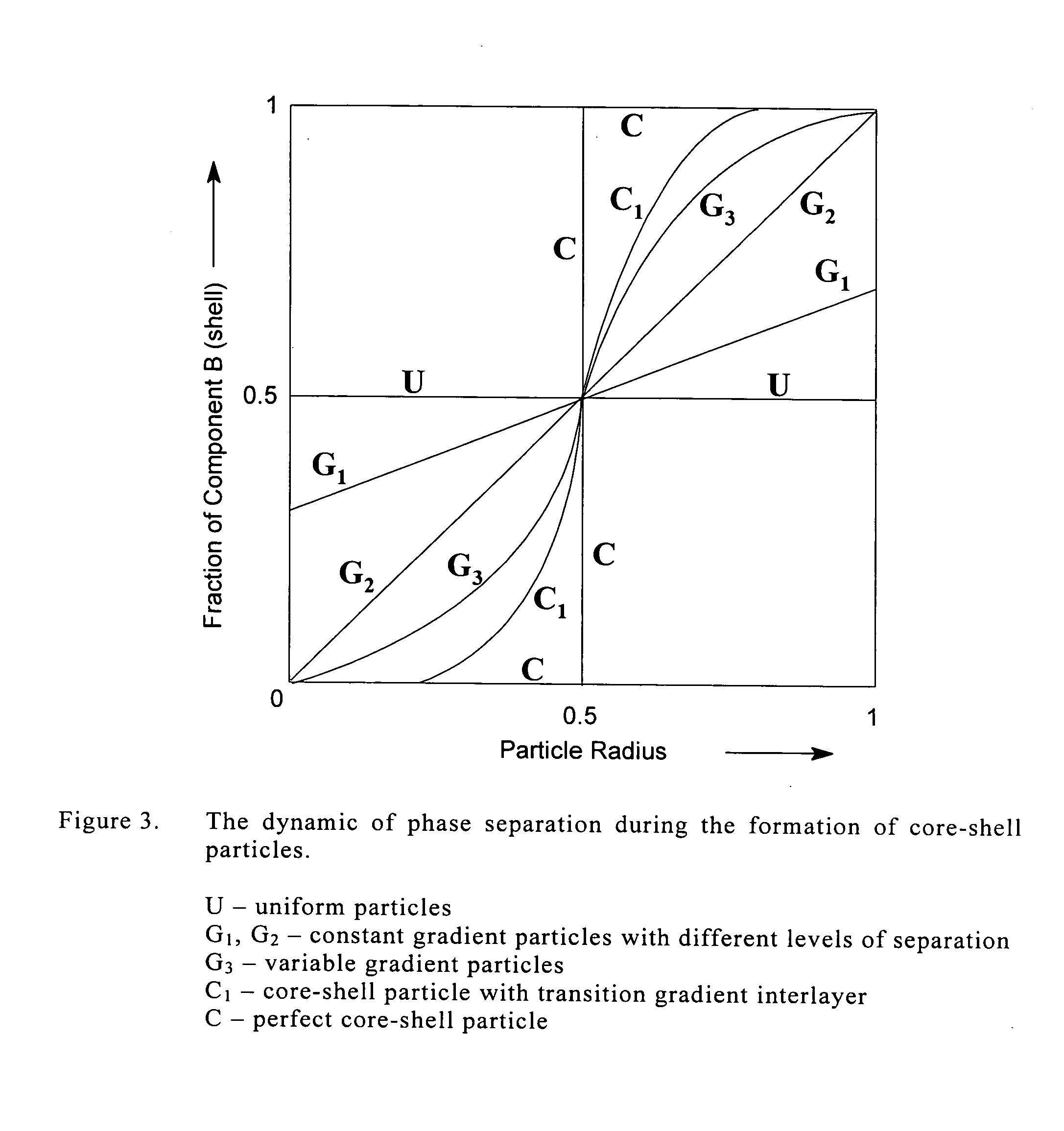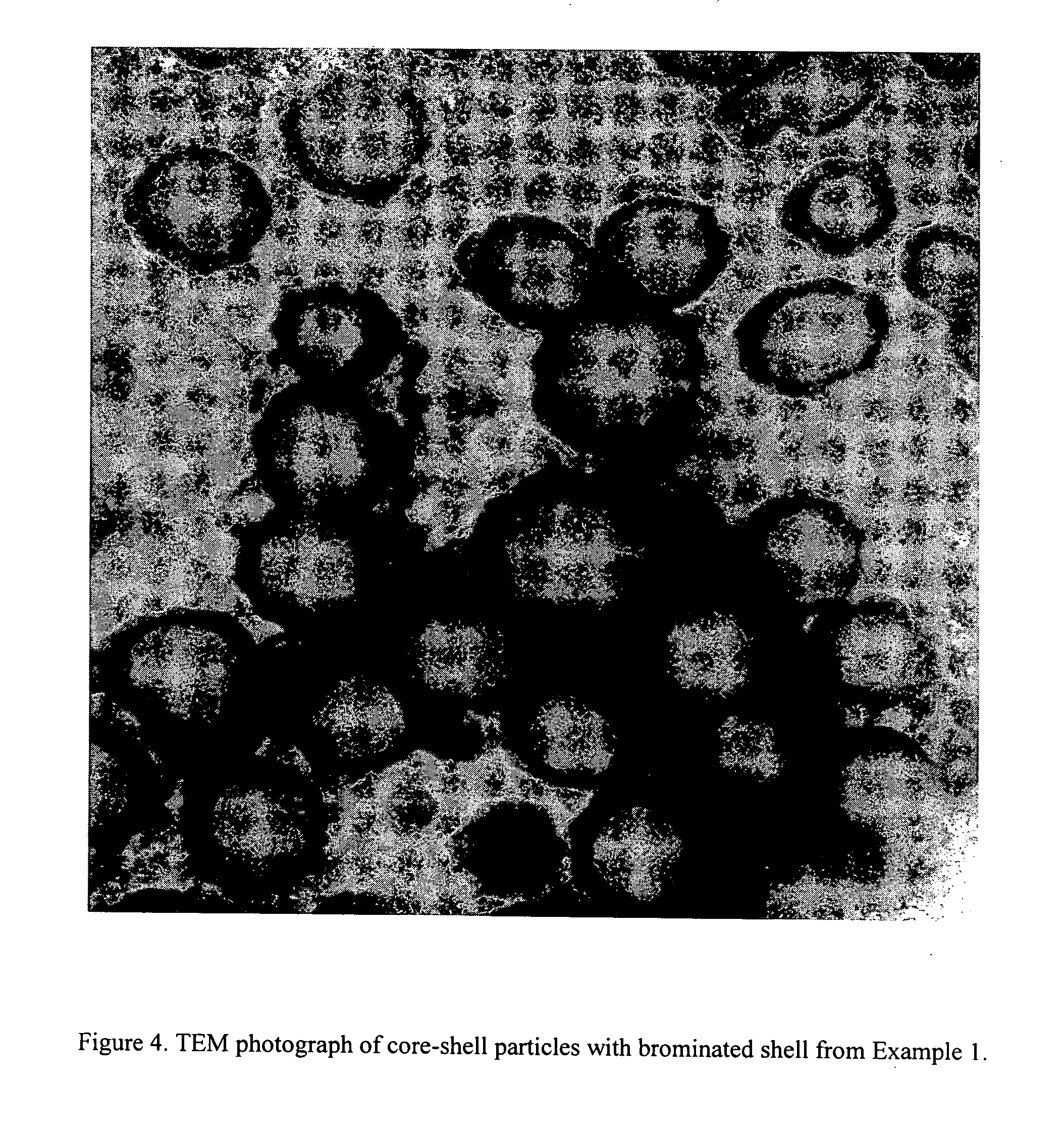Water dispersions of non-uniform polyurethane particles
a polyurethane and non-uniform technology, applied in the field of polyurethanes, can solve the problems of not revealing a method of preparing water dispersible non-uniform, in particular core-shell polyurethanes
- Summary
- Abstract
- Description
- Claims
- Application Information
AI Technical Summary
Benefits of technology
Problems solved by technology
Method used
Image
Examples
example 1
Polyester Core / Brominated Polyether Shell
Preparation of Core Prepolymer
1949 g of 67-1000 HNA, (OH number 121.5 mg KOH / g) and 1052 g of Desmodur W were charged to a reactor. The reaction mixture was heated to about 230° F. (110° C.) and allowed to cool and equilibrate at 210-215° F. (98.9-101.6° C.). The mixture was stirred under a blanket of nitrogen for 3 hours. The remaining NCO was measured at 5.21%. The reactor was cooled to 180° F. (82.2° C.).
Preparation of Shell Prepolymer
The following materials were charged to a reactor: 81 g of PPG-1025 (OH number 110.6 mg KOH / g), 157 g of IPDI and 13.4 g of FR-522 and heated to 190° F. (87.8° C.). 60 g of NMP was charged to the reactor followed by 32 g of DMPA and the mixture was heated to 210° F. (98.9° C.) under a blanket of nitrogen. One drop of the catalyst FASCAT® was added and the reaction mixture was stirred at 210-220° F. (98.9-104.4° C.) for 2.5 hours under a blanket of nitrogen. The remaining NCO was measured at 8.10%. The...
example 2
Polyester Core / Polycarbonate Shell
Preparation of Core Prepolymer
The following materials were charged to a reactor: 307 g of 67-1000 HNA (OH number 120.7 mg KOH / g), 173 g of Desmodur W and 120 g of NMP. The reaction mixture was then heated to 210-220° F. (98.9-104.4° C.) and stirred 1 hour under a blanket of nitrogen. One drop of the catalyst FASCAT® was added. Stirring was continued at 210-220° F. (98.9-104.4° C.) for another 1.5 hours. The remaining NCO was measured at 3.84%. The reactor was cooled to 180° F. (82.2° C.).
Preparation of Shell Prepolymer
The following materials were charged to a reactor: 44 g of Ruco 337 (OH number 130.1 mg KOH / g), 46 g of DMPA, 208 g of Desmodur W and 128 g of NMP. The reaction mixture was then heated to 200-220° F. (93.3-104.4° C.) and stirred 1 hour under a blanket of nitrogen. One drop of the catalyst FASCAT® was added. Stirring was continued at 210-220° F. (98.9-104.4° C.) for another 1.5 hours. The remaining NCO was measured at 6.45%. The...
example 3
One-Pot Synthesis (Compare with Example 2)
Prepolymer
The following materials were charged to a reactor: 193 g of 67-1000 HNA (OH number 120.7 mg KOH / g), 44 g of Ruco 337 (OH number 130.1 mg KOH / g), 46 g of DMPA, 314 g of Desmodur W and 203 g of NMP. The reaction mixture was then heated to 200-220° F. (93.3-104.4° C.) and stirred 1 hour under a blanket of nitrogen. One drop of the catalyst FASCAT® was added. Stirring was continued at 210-220° F. (98.9-104.4° C.) for another 1.5 hours. The remaining NCO was measured at 6.45%. The prepolymer was cooled to 145-150° F. (62.8-65.5° C.). 38.3 g of TEA was charged to the prepolymer and allowed to mix for 35 min.
Dispersion and Extension
Neutralized prepolymer (700 grams) was charged over the course of about 5 minutes with mixing into water (2966 grams) at ambient temperature. The mixture was stirred for another 1 hour and to the formed dispersion, 23 g of hydrazine solution (35% wt.) was added. Dispersion properties: T.S.=17.7%, pH=8.2...
PUM
| Property | Measurement | Unit |
|---|---|---|
| number average particle size | aaaaa | aaaaa |
| number average particle size | aaaaa | aaaaa |
| weight | aaaaa | aaaaa |
Abstract
Description
Claims
Application Information
 Login to View More
Login to View More - R&D
- Intellectual Property
- Life Sciences
- Materials
- Tech Scout
- Unparalleled Data Quality
- Higher Quality Content
- 60% Fewer Hallucinations
Browse by: Latest US Patents, China's latest patents, Technical Efficacy Thesaurus, Application Domain, Technology Topic, Popular Technical Reports.
© 2025 PatSnap. All rights reserved.Legal|Privacy policy|Modern Slavery Act Transparency Statement|Sitemap|About US| Contact US: help@patsnap.com



